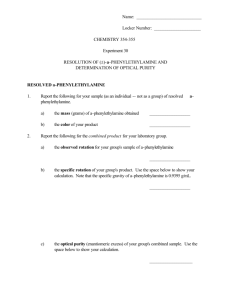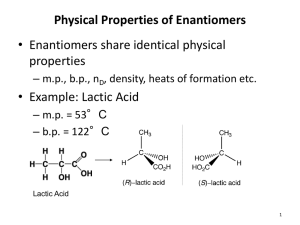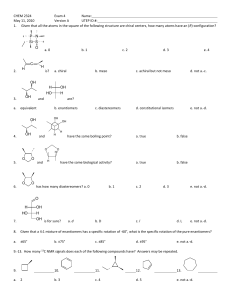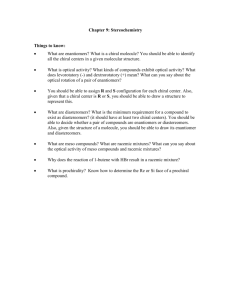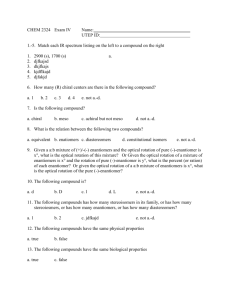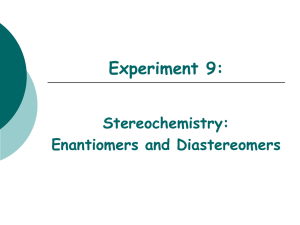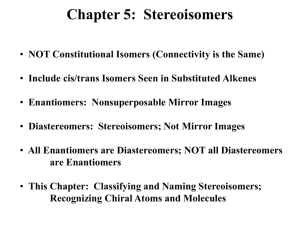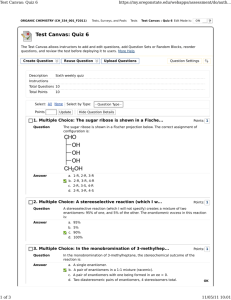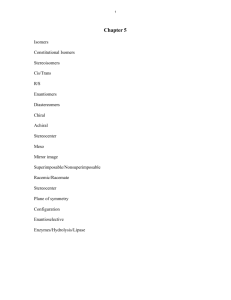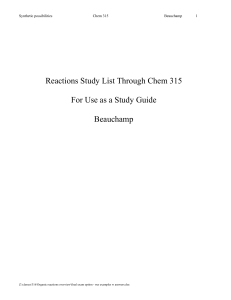Chemistry 0310 - Organic Chemistry 1 Chapter 5. Stereochemistry
advertisement
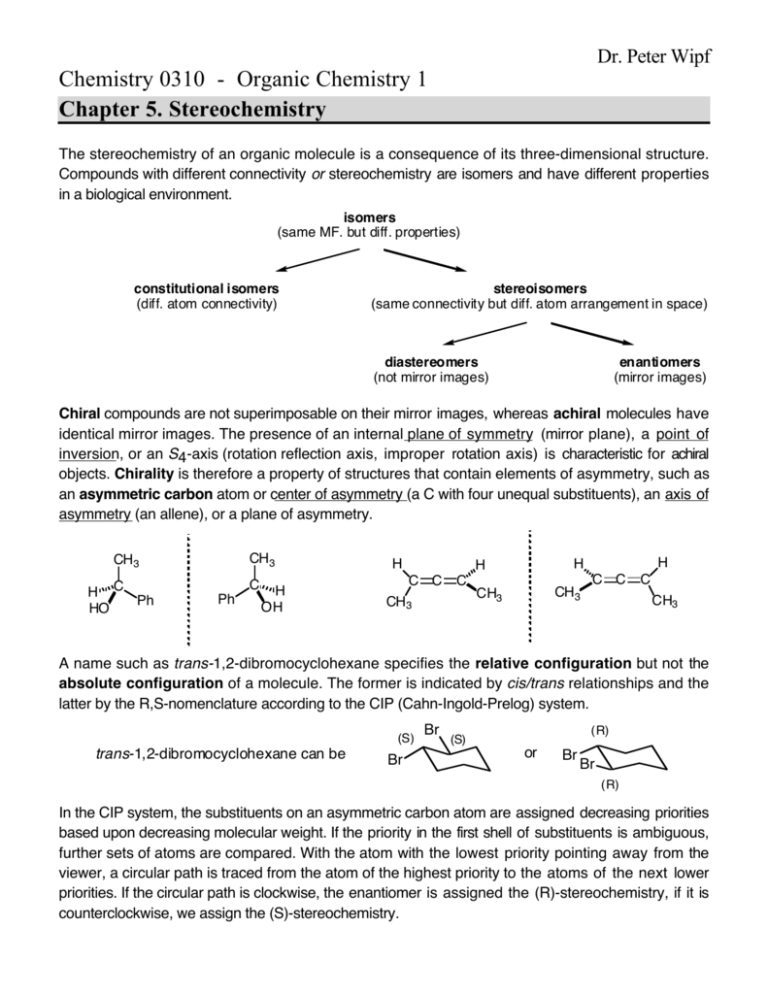
Dr. Peter Wipf Chemistry 0310 - Organic Chemistry 1 Chapter 5. Stereochemistry The stereochemistry of an organic molecule is a consequence of its three-dimensional structure. Compounds with different connectivity or stereochemistry are isomers and have different properties in a biological environment. isomers (same MF. but diff. properties) constitutional isomers (diff. atom connectivity) stereoisomers (same connectivity but diff. atom arrangement in space) diastereomers (not mirror images) enantiomers (mirror images) Chiral compounds are not superimposable on their mirror images, whereas achiral molecules have identical mirror images. The presence of an internal plane of symmetry (mirror plane), a point of inversion, or an S4-axis (rotation reflection axis, improper rotation axis) is characteristic for achiral objects. Chirality is therefore a property of structures that contain elements of asymmetry, such as an asymmetric carbon atom or center of asymmetry (a C with four unequal substituents), an axis of asymmetry (an allene), or a plane of asymmetry. CH3 CH3 H C Ph HO C Ph H OH H C CH3 H H H C C CH3 CH3 C C C CH3 A name such as trans-1,2-dibromocyclohexane specifies the relative configuration but not the absolute configuration of a molecule. The former is indicated by cis/trans relationships and the latter by the R,S-nomenclature according to the CIP (Cahn-Ingold-Prelog) system. (S) trans-1,2-dibromocyclohexane can be Br Br (S) (R) or Br Br (R) In the CIP system, the substituents on an asymmetric carbon atom are assigned decreasing priorities based upon decreasing molecular weight. If the priority in the first shell of substituents is ambiguous, further sets of atoms are compared. With the atom with the lowest priority pointing away from the viewer, a circular path is traced from the atom of the highest priority to the atoms of the next lower priorities. If the circular path is clockwise, the enantiomer is assigned the (R)-stereochemistry, if it is counterclockwise, we assign the (S)-stereochemistry. If a molecule is achiral, but nonetheless contains asymmetric carbons, it is called a meso compound. Br meso 1,3-dibromocyclohexane: (R) (S) ≡ Br Br Br (S) (R) A 1 : 1 mixture of enantiomers is called a racemic mixture. Mixtures that are enriched in one enantiomer over another are called scalemic or enantiomerically enriched. Enantiomers rotate the plane of polarized light in equal amounts but in opposite directions. The specific rotation is the degree that the plane of polarization of the light is rotated after passing through a solution of an enantiomer. a 25 [ a ]D = specific rotation = c •l D: sodium-D-line (589 nm); a: observed rotation angle; c: concentration in g/mL; l: length of cell in dm. There is no intuitive correlation between the configuration of enantiomers and the sign (+, or -) or the value of their specific rotation, but ab initio calculations of Rosenfeld’s equation can be used to compute the optical rotation values. The rotation of an enantiomerically enriched mixture can be used to assess its degree of optical purity (ratio of enantiomers) if the [a]D of a pure enantiomer is known. For two enantiomers A and A': obs [A ]- [A' ] [a ]D % optical purity = % enantiomeric excess (ee) = ¥100 = pure enant. ¥ 100 [A] + [A' ] [ a ]D The ratio of enantiomers [A]/[A’] can be calculated accordingly: [A] 100 + %ee = [ A' ] 100 - %ee The process of separating enantiomers is called resolution. Generally, chemical resolution is performed by the reversible conversion of a racemic mixture to diastereomers, which can b e separated according to their different physical properties. The chlorination of (S )-2-bromobutane provides single enantiomers, a racemic mixture, or diastereomers, depending on what carbon atoms are chlorinated. Diastereomers are formed via diastereomeric transition states and are generally obtained in unequal ratios. Fischer projection formulas are two-dimensional representations of configurations that are still widely used in biochemistry. Fischer projection formulas of D-(2S,3S) and meso-tartaric acid: CO2H HO H CO2H H H OH OH H OH CO2H CO2H
